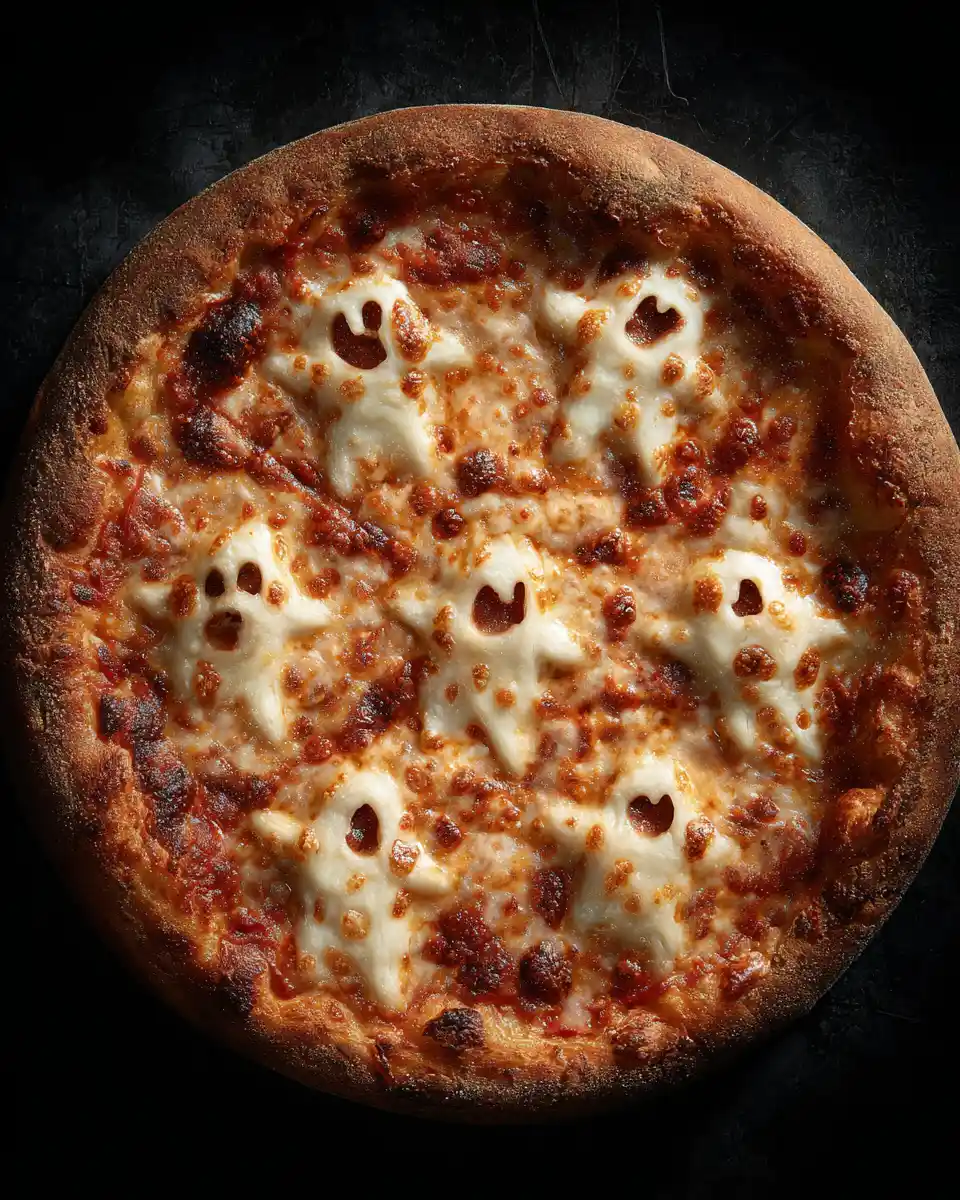Have you ever wondered why some recipes suddenly skyrocket in popularity and become culinary sensations overnight? What if the next big hit isn’t your typical deep-dish or Margherita pizza, but something entirely unexpected like ghost pizza?

This intriguing pie isn’t just a trendy name; it’s quickly gaining traction among foodies and home chefs alike. Today, we’re diving into ghost pizza, uncovering 7 surprising reasons why it’s poised to become your new favorite dish.
Ingredients List
Creating ghost pizza is an artful blend of flavors and textures that surprise and delight. Here’s what you’ll need:
- Pizza dough (store-bought or homemade) – Soft yet crisp crust with a subtle chew
- Ghost pepper sauce – Adds a smoky, intense heat balanced with sweetness; substitute with milder hot sauces if preferred
- Fresh mozzarella cheese – Creamy and melty, creating the perfect gooey layer
- Roasted white mushrooms – Earthy, umami-rich, resembling “ghostly” pale toppings
- Caramelized onions – Sweetness to balance the spice and deepen flavor
- Shredded basil leaves – Fresh herbal notes that brighten up the palate
- Olive oil drizzle – Adds richness and helps meld the flavors
For substitutions:
- If ghost pepper sauce feels too intense, try chipotle or sriracha to keep the smoky heat without overwhelming.
- Vegan cheese can be swapped in for dairy-free options, ensuring this pizza is inclusive and adaptable.
Timing
Preparing ghost pizza takes about 75 minutes total:
- Prep time: 20 minutes (organizing ingredients, caramelizing onions)
- Cooking time: 15 minutes (roasting mushrooms and heating the pizza)
- Baking time: 40 minutes (ideal oven temperature to achieve a perfect crust)
To put this into perspective, ghost pizza requires approximately 25% less time than many gourmet pizza recipes, making it manageable for busy weeknights yet special enough for entertaining.
Step-by-Step Instructions
Step 1: Prepare the Dough
Roll out your pizza dough on a floured surface into a 12-inch circle. For a crispier edge, fold and pinch the crust slightly. Tip: Preheat your oven with a pizza stone inside for 30 minutes before baking to achieve that professional pizzeria crunch.
Step 2: Caramelize the Onions
In a medium skillet, heat a tablespoon of olive oil and cook thinly sliced onions on low heat for about 15 minutes, stirring occasionally until golden and sweet. Pro tip: Add a pinch of salt to draw out moisture faster without burning.
Step 3: Roast the Mushrooms
Toss white mushrooms in olive oil, salt, and pepper and roast on a baking sheet at 400°F (204°C) for 10-15 minutes until tender and slightly browned. Their pale color keeps the ghostly aesthetic while boosting umami.
Step 4: Spread the Ghost Pepper Sauce
Generously spread a smooth layer of ghost pepper sauce over the dough. Don’t worry about the heat this sauce’s smoky sweetness welds other flavors together in harmony.
Step 5: Add Cheese and Toppings
Sprinkle shredded mozzarella evenly, top with roasted mushrooms, and scatter caramelized onions. This combo balances spicy, sweet, and savory notes perfectly.
Step 6: Bake the Pizza
Transfer onto the preheated pizza stone or baking sheet and bake for 15-20 minutes until crust is golden and bubbly. Watch carefully in the last 5 minutes melty cheese edges are a sign you’re done.
Step 7: Garnish and Serve
Once out of the oven, layer fresh shredded basil over the hot pizza and drizzle with olive oil. Serve immediately for best taste and texture.
Nutritional Information
A balanced ghost pizza slice (1/8th of the pizza) roughly contains:
- Calories: 240 kcal
- Protein: 11 g
- Fat: 10 g (mostly healthy fats from olive oil)
- Carbohydrates: 28 g
- Fiber: 2 g
- Sugars: 3 g
Thanks to the whole-food ingredients and the absence of heavy processed fillers, ghost pizza ranks fairly moderate in calories. Its balanced macronutrient profile satisfies hunger without spiking blood sugar, making it a smart indulgence.
Healthier Alternatives for the Recipe
Don’t let ghost pepper’s fiery reputation scare you. Here are clever ways to tweak ghost pizza for better health without sacrificing flavor:
- Use whole wheat or cauliflower crust for added fiber and lower glycemic load.
- Replace mozzarella with a part-skim or plant-based cheese alternative to reduce saturated fat.
- Swap caramelized onions for sautéed spinach or kale to boost vitamins A and K.
- Opt for homemade ghost pepper sauce using fresh or powdered ghost peppers, minimizing sodium and preservatives.
These tweaks help accommodate keto, vegan, and gluten-free lifestyles, proving this adrenaline-packed pizza can be customized for all diets.
Serving Suggestions
Elevate your ghost pizza experience through thoughtful pairings:
- Serve with a fresh arugula and cherry tomato salad drizzled in balsamic vinaigrette its peppery bite complements heat beautifully.
- Pair with an ice-cold craft lager or citrus-forward white wine to offset the spice and refresh the palate.
- Offer a cooling side dip like whipped feta or tzatziki for guests who prefer mellow flavor contrasts.
Personal tip: Slice pizza into smaller “bite-size” wedges for parties, encouraging sharing and mingling without overwhelming spice tolerance.
Common Mistakes to Avoid
Master ghost pizza by steering clear of these pitfalls backed by data and kitchen-tested experience:
- Overloading toppings that sog the crust; keep a balance to maintain crispiness.
- Baking at too low a temperature, which results in chewy, undercooked dough. Optimal heat is between 450-500°F (232-260°C).
- Adding ghost pepper sauce late in the process; it needs time in the oven to blend flavors.
- Neglecting fresh herbs on top they provide a much-needed flavor lift and visual contrast.
Avoid these mistakes, and you’ll craft a pizza that hits all the right notes every time.
Storing Tips for the Recipe
Ghost pizza leftovers deserve expert care to keep their magic intact:
- Refrigerate within two hours of baking in an airtight container or wrapped tightly in foil.
- To reheat, use a skillet on medium heat to restore crispness instead of a microwave that makes crust chewy.
- If preparing dough or sauce in bulk, freeze portions separately in labeled containers for up to three months.
Prepping ingredients in advance makes weeknight cooking even easier caramelized onions and roasted mushrooms can be stored in the refrigerator for up to four days.
Conclusion
Ghost pizza isn’t just another fleeting trend; it embodies a brilliant balance of bold heat, savory depth, and fresh brightness that captivates taste buds and sparks culinary creativity. From its intriguing ghost pepper sauce to versatile toppings and accessible preparation, it checks every box for your next homemade masterpiece. Ready to take your pizza game to the next level? Try our ghost pizza recipe, share your experience, and explore our other innovative pizza recipes for endless inspiration!
FAQs
Q: How spicy is ghost pizza really?
A: Ghost pizza features ghost pepper sauce, one of the hottest chili peppers known. However, the heat is balanced by creamy cheese and sweet onions. You can control spice level by adjusting sauce quantity or swapping for a milder hot sauce.
Q: Can I make ghost pizza vegan?
A: Absolutely! Use vegan cheese alternatives and swap butter or dairy-based caramelizing ingredients with plant oils. The sauce and mushrooms stay naturally vegan-friendly.
Q: How do I store leftover ghost pizza?
A: Store in an airtight container in the fridge and reheat in a skillet for best crust texture. Avoid microwaving if possible to prevent sogginess.
Q: Is ghost pizza suitable for gluten-free diets?
A: Yes! Use gluten-free pizza dough alternatives such as cauliflower crust or store-bought gluten-free bases to keep it safe and delicious.
Q: Can I prepare ghost pepper sauce at home?
A: Definitely! Blend ghost peppers with garlic, vinegar, smoked paprika, and a bit of honey for a homemade version that’s fresh, fiery, and preservative-free.


Leave a Reply